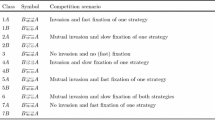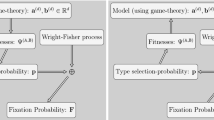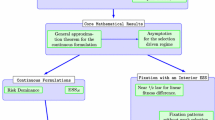Abstract
We consider evolutionary game dynamics in a finite population of size N. When mutations are rare, the population is monomorphic most of the time. Occasionally a mutation arises. It can either reach fixation or go extinct. The evolutionary dynamics of the process under small mutation rates can be approximated by an embedded Markov chain on the pure states. Here we analyze how small the mutation rate should be to make the embedded Markov chain a good approximation by calculating the difference between the real stationary distribution and the approximated one. While for a coexistence game, where the best reply to any strategy is the opposite strategy, it is necessary that the mutation rate μ is less than N −1/2exp[−N] to ensure that the approximation is good, for all other games, it is sufficient if the mutation rate is smaller than (N ln N)−1. Our results also hold for a wide class of imitation processes under arbitrary selection intensity.
Similar content being viewed by others
References
Antal T, Scheuring I (2006) Fixation of strategies for an evolutionary game in finite populations. Bull Math Biol 68: 1923–1944
Antal T, Nowak MA, Traulsen A (2009) Strategy abundance in 2 × 2 games for arbitrary mutation rates. J Theor Biol 257: 340–344
Antal T, Ohtsuki H, Wakeley J, Taylor PD, Nowak MA (2009) Evolution of cooperation by phenotypic similarity. Proc Natl Acad Sci USA 106: 8597–8600
Antal T, Traulsen A, Ohtsuki H, Tarnita CE, Nowak MA (2009) Mutation-selection equilibrium in games with multiple strategies. J Theor Biol 258: 614–622
Blume LE (1993) The statistical mechanics of strategic interaction. Games Econ Behav 5: 387–424
Brémaud P (1999) Markov chains: Gibbs fields, Monte Carlo simulation, and queues. Springer, Berlin
Bürger R (2000) The mathematical theory of selection, recombination, and mutation. Wiley, New York
Chalub FA, Souza MO (2009) From discrete to continuous evolution models: A unifying approach to drift-diffusion and replicator dynamics. Theor Popul Biol 76: 268–277
Claussen JC, Traulsen A (2005) Non-Gaussian fluctuations arising from finite populations: exact results for the evolutionary Moran process. Phys Rev E 71: 025101(R)
Cressman R (1992) The stability concept of evolutionary game theory. Lecture Notes in Biomathematics, vol 94. Springer, Berlin
Crow JF, Kimura M (1970) An introduction to population genetics theory. Harper and Row, New York
Durrett R (1996) Probability: theory and examples. Citeseer
Ewens WJ (2004) Mathematical population genetics. Springer, New York
Foster D, Young P (1990) Stochastic evolutionary game dynamics. Theor Popul Biol 38: 219–232
Fudenberg D, Harris C (1992) Evolutionary dynamics with aggregate shocks. J Econ Theory 57: 420–441
Fudenberg D, Imhof LA (2006) Imitation process with small mutations. J Econ Theory 131: 251–262
Fudenberg D, Imhof LA (2008) Monotone imitation dynamics in large populations. J Econ Theory 140: 229–245
Gardiner CW (2004) Handbook of Stochastic Methods, 3rd edn. Springer, New York
Goel N, Richter-Dyn N (1974) Stochastic models in biology. Academic Press, New York
Hauert C, Traulsen A, Brandt H, Nowak MA, Sigmund K (2007) Via freedom to coercion: the emergence of costly punishment. Science 316: 1905–1907
Hofbauer J, Sigmund K (1998) Evolutionary games and population dynamics. Cambridge University Press, Cambridge
Imhof LA, Nowak MA (2006) Evolutionary game dynamics in a Wright Fisher process. J Math Biol 52: 667–681
Imhof LA, Fudenberg D, Nowak MA (2005) Evolutionary cycles of cooperation and defection. Proc Natl Acad Sci USA 102: 10797–10800
Kallenberg O (2002) Foundations of modern probability. Springer, Berlin
Kampen NGv (1997) Stochastic processes in physics and chemistry, 2nd edn. Elsevier, Amsterdam
Kandori M, Mailath GJ, Rob R (1993) Learning, mutation, and long run equilibria in games. Econometrica 61: 29–56
Karlin S, Taylor HMA (1975) A first course in stochastic processes, 2nd edn. Academic, London
Levin DA, Peres Y, Wilmer EL (2009) Markov chains and mixing times. American Mathematical Society, Providence
Nowak MA (2006) Evolutionary dynamics. Harvard University Press, Cambridge
Nowak MA, Sasaki A, Taylor C, Fudenberg D (2004) Emergence of cooperation and evolutionary stability in finite populations. Nature 428: 646–650
Ohtsuki H, Hauert C, Lieberman E, Nowak MA (2006) A simple rule for the evolution of cooperation on graphs. Nature 441: 502–505
Roca CP, Cuesta JA, Sanchez A (2009) Evolutionary game theory: temporal and spatial effects beyond replicator dynamics. Phys Life Rev 6: 208–249
Santos FC, Pacheco JM (2005) Scale-free networks provide a unifying framework for the emergence of cooperation. Phys Rev Lett 95: 098104
Sella G, Hirsh AE (2005) The application of statistical physics to evolutionary biology. Proc Natl Acad Sci USA 102(27): 9541–9546
Sigmund K, DeSilva H, Traulsen A, Hauert C (2010) Social learning promotes institutions for governing the commons. Nature 466: 861–863
Szabó G, Fáth G (2007) Evolutionary games on graphs. Phys Rep 446: 97–216
Szabó G, Tőke C (1998) Evolutionary Prisoner’s Dilemma game on a square lattice. Phys Rev E 58: 69
Tarnita CE, Ohtsuki H, Antal T, Fu F, Nowak MA (2009) Strategy selection in structured populations. J Theor Biol 259: 570–581
Taylor C, Fudenberg D, Sasaki A, Nowak MA (2004) Evolutionary game dynamics in finite populations. Bull Math Biol 66: 1621–1644
Traulsen A, Nowak MA (2007) Chromodynamics of cooperation in finite populations. PLoS One 2: e270
Traulsen A, Nowak MA, Pacheco JM (2006) Stochastic dynamics of invasion and fixation. Phys Rev E 74: 011909
Traulsen A, Shoresh N, Nowak MA (2008) Analytical results for individual and group selection of any intensity. Bull Math Biol 70: 1410–1424
Traulsen A, Hauert C, De Silva H, Nowak MA, Sigmund K (2009) Exploration dynamics in evolutionary games. Proc Natl Acad Sci USA 106: 709–712
Van Segbroeck S, Santos FC, Lenaerts T, Pacheco JM (2009) Reacting differently to adverse ties promotes cooperation in social networks. Phys Rev Lett 102: 058105
van Veelen M (2007) Hamilton’s missing link. J Theor Biol 246: 551–554
Wang J, Wu B, Chen X, Wang L (2010) Evolutionary dynamics of public goods games with diverse contributions in finite populations. Phys Rev E 81: 056103
Wu B, Altrock PM, Wang L, Traulsen A (2010) Universality of weak selection. Phys Rev E 82: 046106
Author information
Authors and Affiliations
Corresponding author
Rights and permissions
About this article
Cite this article
Wu, B., Gokhale, C.S., Wang, L. et al. How small are small mutation rates?. J. Math. Biol. 64, 803–827 (2012). https://doi.org/10.1007/s00285-011-0430-8
Received:
Revised:
Published:
Issue Date:
DOI: https://doi.org/10.1007/s00285-011-0430-8




